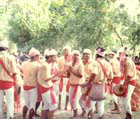 |
| a home away from home |
| HOME FEEDBACK TELL A FRIEND WEB SITE DESIGN CAREER WITH US CONTACT US |
![]() Festivals
Festivals
![]() Durga Puja
Durga Puja
![]() Associations
Associations
![]() Learn Bangla
Learn Bangla
![]() Beng. Marriage
Beng. Marriage
![]() Art & Craft
Art & Craft
![]() Great Indians
Great Indians
![]() Beauty Care
Beauty Care
![]() Recipe
Recipe
![]() Astrology
Astrology
![]() Beng. Section
Beng. Section
![]() Bengal
Bengal
![]() Calcutta
Calcutta
![]() Beng. Calendar
Beng. Calendar
![]() Wallpapers
Wallpapers
![]() Movie
Movie
![]() Music
Music
![]() E-Card
E-Card
![]() Shopping
Shopping
![]() E-Puja Room
E-Puja Room
![]() News
News
![]() E-mail
E-mail
![]() Month's Events
Month's Events
![]() Weather
Weather
![]() Chat
Chat
![]() Travel
Travel
![]() Join Us
Join Us
![]() Advertise
Advertise
![]() Website links
Website links
![]() Link to us
Link to us
![]() Guest Corner
Guest Corner
![]() Services
Services
![]() WebSite Design
WebSite Design

Each day of Bihu has a specific name. The first one, Garer Bihu is the actual day of Sankranti also known as Uraka: this is the Bihu of the cows. On this day cows are taken to the river and bathed with great love and care. Then they are brushed and their hooves and horns are cleaned. They then feed the cows with small pieces of gourd
and
brinjal. For household special food is prepared. Many kinds of sweets
are made and families and friends enjoy with each other’s hospitality.
The second day of Bihu is known as Manuhar Bihu. From this day the Assamese
start to count their new year. The food for the feast is pitha, laddoo
and til laddu.
The third day is known as Gabhori Bihu. Women sing under the banyan trees through out the day and night. Then the women dance accompanied by many musical instruments, like-dhol, gogona, pepa etc. On the last day each household writes the ‘mantra’. The second Bihu is known as Kati Bihu held in the month of Kartik or Sankranti. This is a Bihu of silent prayer and meditation by setting a little lamp in the farm land in a wish of good cultivation. It is the most quiet and peaceful Bihu among the three. Third Bihu or Magh Bihu falls on 14 January in the month of Magh.
The emphasis is on eating. This is celebrated for seven days and almost like Rangoli Bihu. There is also a great feast named ‘bhog’. Khel Dhameli (play and fun) is also there. Bonfire is an important part of it where all the people including men and women enjoy the singing and dancing.
A
variety of traditional Assamese sweets and cakes like the Laddu, Pitha
etc. are prepared for this occasion in each and every home. The next day
is spent by visiting relatives and friends to convey and exchange the
Bihu greetings and wishes. The guests, neighbours and relatives exchange
the snacks prepared for the occasion.
This enjoyment, merriment, fun and frolics remind us the Lohri in Punjab
and Pongal in Tamilnadu. Magh Bihu coincides with Goopi of Andhra Pradesh
and Makar Sankranti of North India. So this is the festive season of all
over India in one form or another with bonfires.
GREAT INDIANS || BENGALI SECTION || BENGALI MARRIAGE || BABY'S NAME || WALLPAPER || BENGAL || WEATHER || TRAVEL
MOBILE WALLPAPER || E-CARD || MOVIE || WEBSITE LINKS || ASSOCIATIONS || SHOPPING || ASTROLOGY || MUSIC || BEAUTY CARE
TIGER || NEWS || GUEST CORNER || FEEDBACK || LINK TO US || FOR ADVERTISING || SERVICES || CONTACT || BENGALI CALENDAR
Graphics, Sound or content copied or produced in part or whole in any media will be illegal.
Persons or websites caught using our material will be penalized.
Privacy Statement || Copyright
Copyright ©1999-2014 BANGALINET.COM